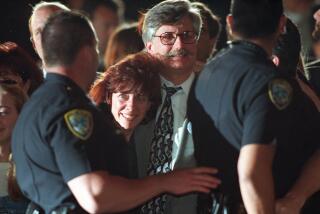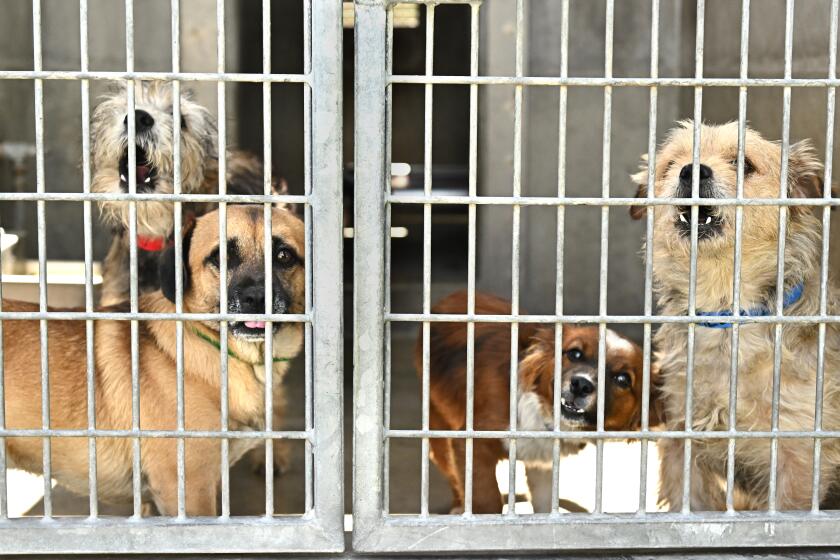Horses, once prized, are paying for the dire economy
Black as night and 18 hands high, Clemente trotted up and down the pen as the auctioneer at Mike’s Livestock rattled off bids machine-gun style.
The barnyard scents of alfalfa, leather and sweat wafted through the cavernous auction hall just outside Riverside, where Clemente and dozens of other horses paraded before bleachers overflowing with bargain-seekers, sellers and gawkers on a cold weekend night.
There were whispers of a “killer buyer” lurking outside, buying up swaybacks and broken-down mares to be shipped off for slaughter. A trio of amateur Mexican-style rodeo riders eyed horses suitable for hogtying and tail twisting.
VIDEO: A home for the unwanted horses
Benedict Vazquez bought Clemente, a Tennessee walker, three years ago for $2,000 and kept the horse — at 18 hands, or 5 feet tall at his shoulders, tall even for his breed — in his backyard stable in Compton. But it’s been slow at the print shop where he works, and Christmas is coming. Hay is creeping toward $20 a bale, double the price of just a few years ago.
Vazquez hoped to pocket $500 at the auction. Bidding started at $280. But there were no takers. At the end of the night, he walked away with $140, minus a 10% auction fee.
“We don’t know who bought it,” said his 11-year-old son, Benedict Jr. “I’m a little worried, a little worried that he’ll be OK.”
Arabians, paints and quarter horses that were once prized possessions of families throughout Southern California are increasingly being cut loose as unaffordable luxuries, especially in sprawling, working-class Inland Empire communities trampled by double-digit unemployment and pocked with foreclosed homes.
Some horses are sold off for a fraction of what their owners paid, saving them thousands in feed and care expenses. Scores of others have been abandoned, many found foraging for food along the Santa Ana River near Norco and Pedley or rescued from owners who starved them into bony cripples. Horse sanctuaries, some providing a home for more than 50 head, are struggling to stay afloat, and a few are declining to accept newcomers.
“Up until two or three years ago, we’d find maybe two abandoned horses a year. It’s a horse a week now,” said Allan Drusys, chief veterinarian for Riverside County’s Department of Animal Services.
In October, Riverside County animal control officials seized 15 emaciated horses from a five-acre ranch outside of Murrieta, just weeks after two abandoned and malnourished horses were wandering around the outskirts of Perris. The county’s new animal shelter along the Santa Ana River has a dozen stables, all full, and most horses there are facing possible euthanasia.
The economic crash accounts for only part of these hard times for equines. With higher feed prices, kids consumed by XBoxes and other manna of the electronic age and dense, yardless housing developments swallowing up farmland and ranches, families just don’t have the money, the interest or the space to care for a horse, Drusys said.
Except for high-end race and show horses, the animals just aren’t worth as much anymore. A healthy, trail-riding quarter horse may fetch a few hundred bucks. Owners of an aging or nicked-up mare or stallion often can’t find a buyer.
“There’s no buyers anywhere,” said Jason Hauck, a horse trader and trainer with a ranch outside of Tehachapi. “There’s a guy down the road from me who has 18 head of horses, beautiful broodmares. He says if hay goes above $18 a bale … he’s going to have to literally turn his horses out into the desert. And he’s a man of his word.”
The drought and wildfires that ravaged crops in Texas this year have increased demand for West Coast hay, and more bales are being exported to China and Japan from the ports of Los Angeles and Long Beach. That combined with California farmland’s drop in hay acreage — 12% to 14% over the last six years — has only driven costs higher, said Dan Putnam of UC Davis, who monitors California’s alfalfa crops.
Hauck and many other ranchers blame the deflated horse market and the surge in abandoned horses, in large part, on California’s ban on horse slaughter. The 1998 law made it illegal to buy, sell or export a horse to be slaughtered for human consumption.
Along with bans in California and other states, Congress also imposed a de facto prohibition starting in 2007, when it stripped funds for federal inspections of the facilities that are required for slaughterhouses to operate.
As a result, U.S. horse exports to slaughterhouses in Mexico increased by 600% and to those in Canada jumped 148%, according to a report by the Government Accountability Office. In 2010, nearly 138,000 U.S. horses were slaughtered in those countries, roughly the same number that were slaughtered in the U.S. before the bans.
Closing domestic slaughterhouses also “negatively affected lower- to medium-priced horses by 8 to 21 percent,” exceeding the 4% drop in horse prices caused by the economic downturn, the report found. Those unintended consequences are one reason Congress and the Obama administration quietly lifted the horse ban in November.
“When we had horse slaughter, every horse had a value. Now, without slaughter, if a horse does not ride, or is not a pet, it has no value,” said Mike Murphy, owner of Mike’s Livestock Auction in Mira Loma. “Those are horses being dumped, being let go. The animal do-gooders don’t think about that.”
Selling a horse for slaughter could fetch $25 or more. Hiring a vet to euthanize an animal and to have the carcass hauled away can run $300 to $400, he said.
Decades before the ban, Murphy used to ship horses to a Vernon slaughterhouse for Kal Kan dog food. Later, a Fort Worth slaughterhouse had a standing order for horses that couldn’t sell at auction — $25 a head.
“When they quit that, it hurt the whole horse industry, because you have a lot of bad horses and you can’t do nothing with them,” said Butch Williams, a grizzled horse trader from Hesperia with the gritty voice of Rooster Cogburn. “If they can’t ride ‘em and they can’t feed ‘em, they’ll cut them loose.”
For years, Renee Duncan’s shady 12-acre ranch in Perris has provided a sanctuary for those very horses. The slaughtering of horses — animals that helped settle the Western frontier and are beloved family companions — has no place in civilized society, she said.
Duncan set up Meadowbrook Animal Sanctuary and Haven in 1988, and ever since she has nimbly dodged foreclosure and muddled through personal tragedy — she survived throat cancer and her house was gutted by fire a year ago — to care for 48 horses.
A benefactor from the Northwest bought the ranch from her a few years ago, allowing Duncan to run the nonprofit, but the operation still depends on donations to help cover the $9,000 a month it costs to feed the animals.
“Now we’re on shaky ground. We’ve not missed a feeding, just by the grace of God. We have people helping, donations and my money,” said Duncan, a retired emergency room nurse. “The horses look good, and they eat before I do.”
A few years back, Meadowbrook housed more than 70 horses, with numbers dwindling as the animals were put down by a veterinarian after they fell ill, were injured or became infirm. Duncan has stopped accepting more animals, saying she can’t afford to care for them anymore. Still, the calls keep coming. Some mornings, she’ll find a horse tied up to her fence — and she’ll take it in.
“If I take more, I’ll end up not being able to take care of these horses,” she said, looking toward the corrals that ring the ranch. “It just kills me, but I can’t save the world.”
Under the shade of a eucalyptus tree is the grandson of triple-crown winner Seattle Slew. Duncan said she spotted him at an auction just after he was bought by a killer buyer.
“I begged. He paid $50. He said, ‘We’ll, I’ll sell him to you for $100,’” Duncan said. “He knew I was a sucker.”
VIDEO: A home for the unwanted horses
More to Read
Start your day right
Sign up for Essential California for news, features and recommendations from the L.A. Times and beyond in your inbox six days a week.
You may occasionally receive promotional content from the Los Angeles Times.







